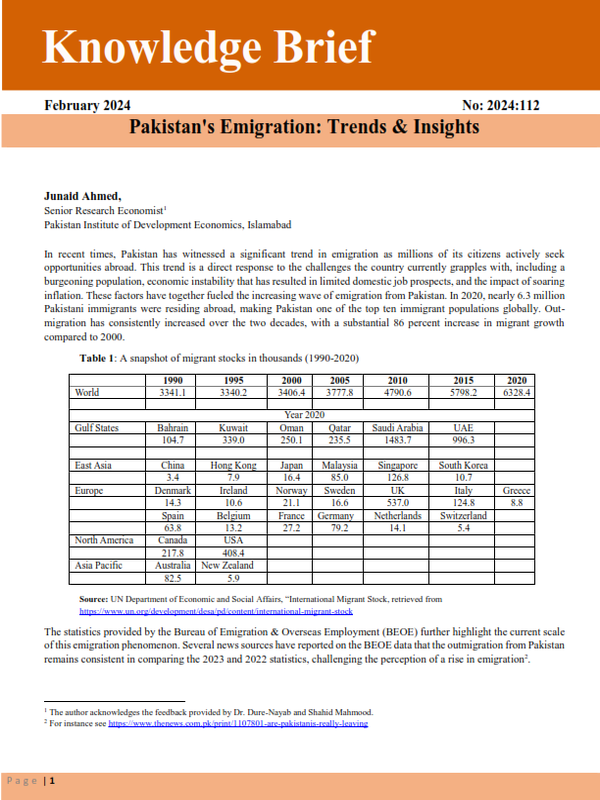
Pakistan Institute of Development Economics
- Home
Our Portals
MenuMenuMenuMenuMenuMenuMenu - ResearchMenuMenuMenuMenuMenuMenuMenu
- Discourse
- The PDR
- Our Researchers
- Academics
- Degree Verification
- Thesis Portal
- Our Portals
Pakistan’s Emigration: Trends & Insights
In recent times, Pakistan has witnessed a significant trend in emigration as millions of its citizens actively seek opportunities abroad. This trend is a direct response to the challenges the country currently grapples with, including a burgeoning population, economic instability that has resulted in limited domestic job prospects, and the impact of soaring inflation. These factors have together fueled the increasing wave of emigration from Pakistan. In 2020, nearly 6.3 million Pakistani immigrants were residing abroad, making Pakistan one of the top ten immigrant populations globally. Outmigration has consistently increased over the two decades, with a substantial 86 percent increase in migrant growth compared to 2000.

The statistics provided by the Bureau of Emigration & Overseas Employment (BEOE) further highlight the current scale of this emigration phenomenon. Several news sources have reported on the BEOE data that the outmigration from Pakistan remains consistent in comparing the 2023 and 2022 statistics, challenging the perception of a rise in emigration2.
___________
[1]The author acknowledges the feedback provided by Dr. Dure-Nayab and Shahid Mahmood.
[2]For instance see “https://www.thenews.com.pk/print/1107801-are-pakistanis-really-leaving”
___________
For instance, in the year 2023, 862,625 people have already emigrated compared to 832,339 people in 2022, suggesting a 3.6 percent increase from the previous year. These statistics indeed warrant a deeper analysis of ongoing migration trends, narrated below.
- EOE’s annual placement data reveals that nearly 96 percent of the Pakistani diaspora managed by the BEOE from 1971 to 2023 were placed in the Persian Gulf region, Notably in Saudi Arabia and the United Arab Emirates (UAE). It depicts only a partial narrative, as it doesn’t include the various migratory movements linked to immigration to other prominent destinations such as the United Kingdom (UK), United States (US), Canada, Australia, Italy, Germany, Spain, Norway, and Ireland, among others. Apart from the data, it doesn’t report data on prominent destinations.
- Beyond the Gulf countries, notable migration patterns emerge in destinations like Malaysia and the UK. The UK. is more likely to stand out as a case of recent brain drain (See Table 2).
- Statistics depict cumulative annual migration flows without any data on the return of migrants to their home countries. This is significant because the absence of a naturalization pathway in Gulf countries is expected to increase the number of returning emigrants.
- BEOE’s data comprises a significant portion of unskilled and semi-skilled workers (See Figure 1), missing the emigration of professionals such as doctors, teachers, IT experts and others. Also, it doesn’t cover movements related to family reunification, education and the settlement of asylum seekers in Western countries in particular.



